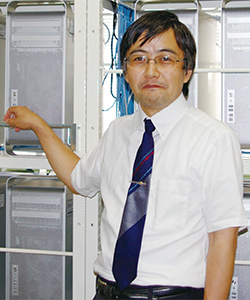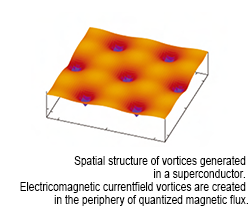Home > Research > Pickup > masanori_ichioka
Elucidating Superconductivity Mechanisms using High-Performance Computers:Seeing superconducting electrons in a vortex

Masanori Ichioka
Professor of Physics
After obtaining his Ph.D. from the Kyoto University, Graduate School of Science, he performed post-doctorate work as a recipient of a Research Fellowship for Young Scientists from the Japan Society for the Promotion of Science. He then served successively as a Research Associate, Assistant Professor, and Associate Professor at the Okayama University (Department of Physics, Faculty of Science). From August 2011, he has served as a Professor at Okayama University, now at the Research Institute for Interdisciplinary Science (RIIS).
Theory of Superconductivity is the specialty of the Mathematical Physics Laboratory led by Professor Ichioka. There they use vortices in electric current to study phenomena in superconductivity, an area of research where Dr. Ichioka is a worldwide leader. Through the powerful use of fundamental physics theories (quantum mechanics and statistical mechanics) and techniques of computation, Professor Ichioka seeks to elucidate the mechanisms of phenomena in superconductivity.
"When you hear the word 'vortex,' what do you imagine? For example, a tornado, which is a vortex of wind, a whirlpool in an ocean current, or a galaxy that is a vortex of stars. The theme of the research I have engaged in as my life work is that of the electromagnetic vortices generated in superconductivity."
While high school students learn that magnetic field lines are merely imaginary, in fact quantized*1 magnetic lines can be counted one by one. These lines of magnetic force actually exist in superconductors.
"Quantizing magnetic lines in superconductors stirs up a peripheral electric current vortex."*2
Professor Ichioka realized that this vortex could be used to investigate the properties of superconducting electronic states.
Peering out from the vortex

The superconductive phenomenon was discovered in 1911. The mechanisms of superconductivity were elucidated by Bardeen, Cooper, and Schrieffer (BCS) in their 1957 BCS superconductivity theory. By the 1980s, it was said that superconductivity research had reached a dead end. Yet in 1986, with the discovery of the copper oxide high temperature superconductor, previous theories no longer applied.
"Let's overthrow this 'we can't understand it' by disintegrating superconductivity!"
His concept was generated by reverse thinking. In a superconducting state, numerous electrons harmonize and move together, making their individual properties difficult to see. Professor Ichioka introduced electromagnetic vortices in the superconductor, going ahead and disturbing the superconductivity. The result was that the properties of the superconducting electrons that were impossible to see before now became clearly visible.
"Looking out from the vortex, one can clearly observe the superconducting electrons."
Professor Ichioka's research clarified that, from the perspective of the vortex, the superconducting electrons within a copper oxide high temperature superconductor have anisotropic energy gaps. This method was further developed and pioneering results were reported in a variety of fields: multiband superconductors, chiral p-wave superconductors, FFLO states, and spin triplet superconductors. These results have sparked worldwide interest in this research method.
Reproducing superconducting vortex states in computer
This research method was based on quantum statistical mechanics theory and parallel computation using 256 CPUs. The computer cluster, constructed within the research lab, boasts several hundred times the computational speed of commercially available computers. In Dr. Ichioka's lab, large-scale theoretical calculations are performed using the lab's own program written in Fortran language. Anyone can perform the calculations required for a single vortex. However, the calculations are extremely difficult for the numerous vortices generated in an actual superconductor. Professor Ichioka has made this possible, making him the global leader in calculations for superconducting vortices.
The desire to understand the strange and mysterious
A superconducting state has as many as 1023 electrons moving together in a harmonious unbroken line, such that the electrical resistance becomes zero. During his high school years, Professor Ichioka was struck with wonder about how such an electronic state could occur. He truly wanted to understand this. This desire served as the impetus for Dr. Ichioka's leadership position today in the world of theoretical physics.
"There are so many phenomena in the world of natural science that are considered strange and mysterious. Superconductivity, superfluidity, and topological electronic states; the list never ends. Why do such things occur? We hope that students who truly seek an understanding by turning back to fundamental theory will come to work together with us in our laboratory. Let us take on this challenge together and try to solve the mysteries of the natural sciences."
*1 "Quantizing" is when a certain physical quantity becomes an integer multiple of a quantum. The quantum is the smallest unit of physics and was proposed and discovered by Max Planck in 1900.
*2 When a magnetic field is applied to a superconductor, the magnetic field is divided into magnetic flux lines (individually called "flux quantum") every 2.07 x 10-15 Webers ("Wb" is the SI unit of magnetic flux), which penetrate the superconductor. At the periphery of these magnetic flux lines, electric current flows in a vortex shape and the superconductivity disintegrates at the center of these magnetic flux lines.







